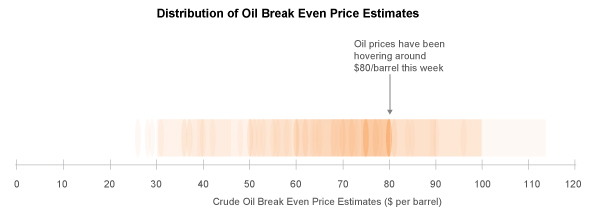Oil has been all over the news this week: Oil prices keep falling. U.S. oil production is the highest it’s been since 1985.
What does it all mean?
To be honest, I don’t know. (No one does!) But here are some ideas that can help us chip away at this hairy, complex question.

Jordan Wirfs-Brock / Inside Energy
Here at Inside Energy, we can’t promise you answers. But we can promise you that we’ll keep asking questions. In fact, we’ll do our best to be the question.
Oil production hinges on one big assumption: Companies extracting oil can make money. For this to be true, the price of oil has to be high enough that oil producing companies can sell oil at a profit. That is, the money companies spend to extract oil – leasing land, purchasing equipment, drilling wells, operating rigs, transporting oil to refineries, paying back loans – has to be less than what they make when they sell the oil.
The price at which producing oil in the U.S. is no longer profitable is often called the “break even price.” Inside Energy compiled all the break even price estimates we could find – estimates from analysts at places like Morgan Stanley and the International Energy Agency quoted in publications like Bloomberg and The Wall Street Journal – and found nearly 50 estimates ranging from less than $30 a barrel to well over $100 a barrel:

Jordan Wirfs-Brock / Inside Energy
This graphic shows the distribution of crude oil break even prices estimates cited in the media, as compiled by Inside Energy. Some estimates are single values ($75/barrel), some are ranges ($30 to $60/barrel). The darker areas represent more common estimates. You can see a cluster of estimates around $80/barrel.
With the current price of crude oil hovering somewhere around $80 a barrel, if $30 per barrel is the break even point, that means oil companies are making $50 per barrel. If $100 is break even, then they are already losing big bucks.
Which is true? They might all be.
There isn’t a single break even price. The oil industry is not uniform. Every company and every oilfield is different. Factors like local geology, tax structure, and amount of debt the company owes mean the break even price varies from place to place, rock to rock, and company to company. (For more on this topic, Inside Energy’s Emily Guerin has a great explanation of how these factors influence break even price estimates in North Dakota.)
To complicate matters, when people talk about break even price, they aren’t always talking about the same thing. Sometimes they are talking about the price where production slows, or profits dip below a certain margin. Sometimes they are talking about shale oil, and sometimes they are talking about all kinds of oil. Sometimes they are talking about the entire U.S., and sometimes they are talking about a particular region, like the Eagle Ford in Texas. (You can see all of these distinctions outlined in our table.)
Just to show you how variable break even prices can be, here’s a map of break even prices for North Dakota’s oil producing counties – ranging from $28 per barrel in McKenzie County to $85 per barrel in Divide – based on data released by the North Dakota Department of Mineral Resources this week:
Because break even prices vary so much, perhaps a better question to ask is: How does production change as the price of oil changes?
In North Dakota, at least, more drilling is happening in counties with lower break even prices – near the easier, more profitable oil. If oil prices continue to stay low for months to come, as some people are predicting, it will be interesting to see how U.S. production adapts. Will it grow or shrink, and how does that affect each and every one of us? That’s a question Inside Energy will be keeping an eye on in the future.
What’s Next:
- View a table of break even estimates that have been published in news articles and reports. Know of an estimate that isn’t on our list? Send it to us at info@insideenergy.org and we’ll add it.
- Read Emily Guerin’s article, “Why $80/Barrel Isn’t The Number North Dakota Should Care About,” to learn about the factors that influence break even price estimates in North Dakota.
- Have a question you’d like to see us answer? Let us know by tweeting it to @InsideEnergyNow and using the hashtag #IEQuestions.








